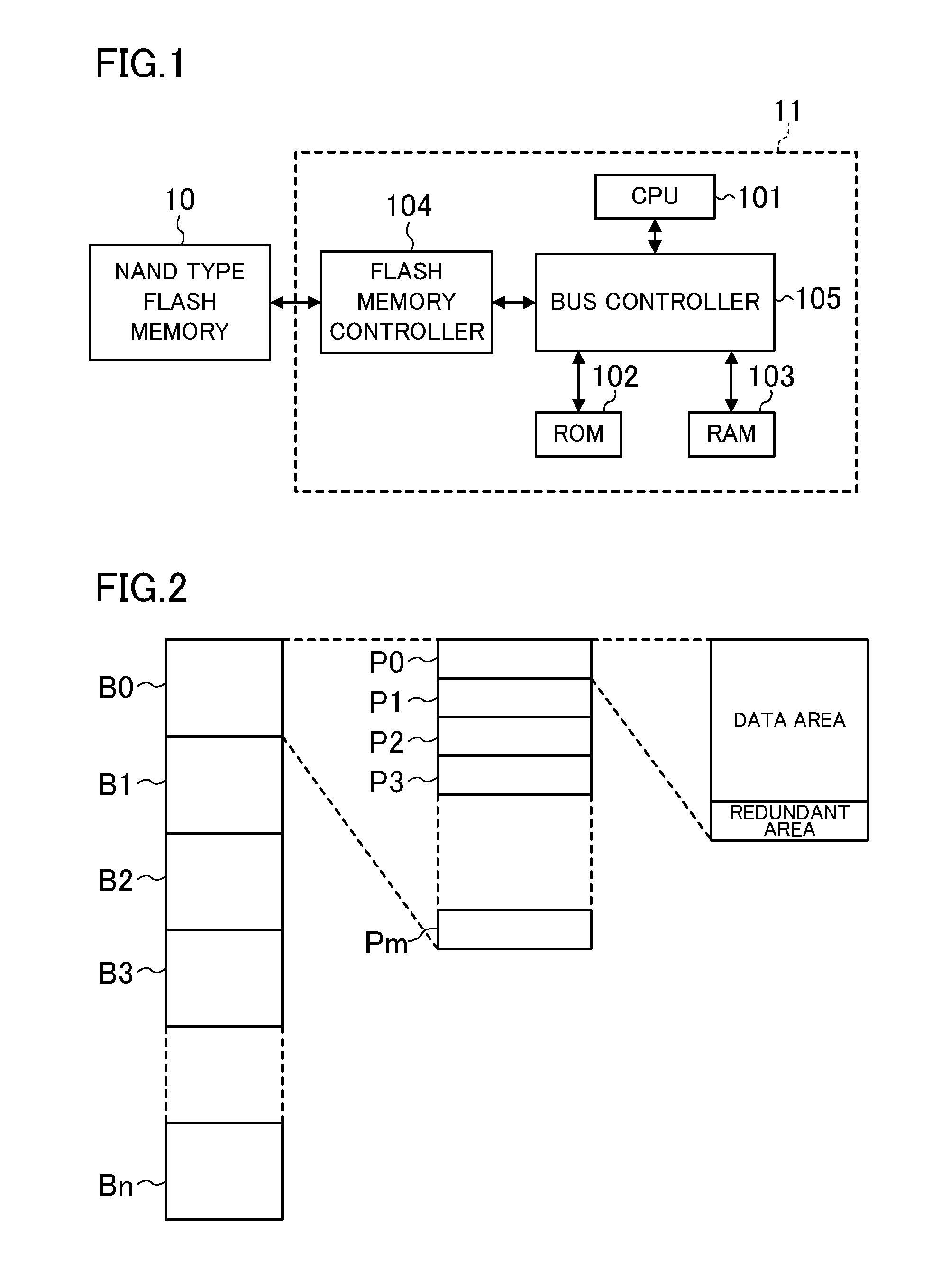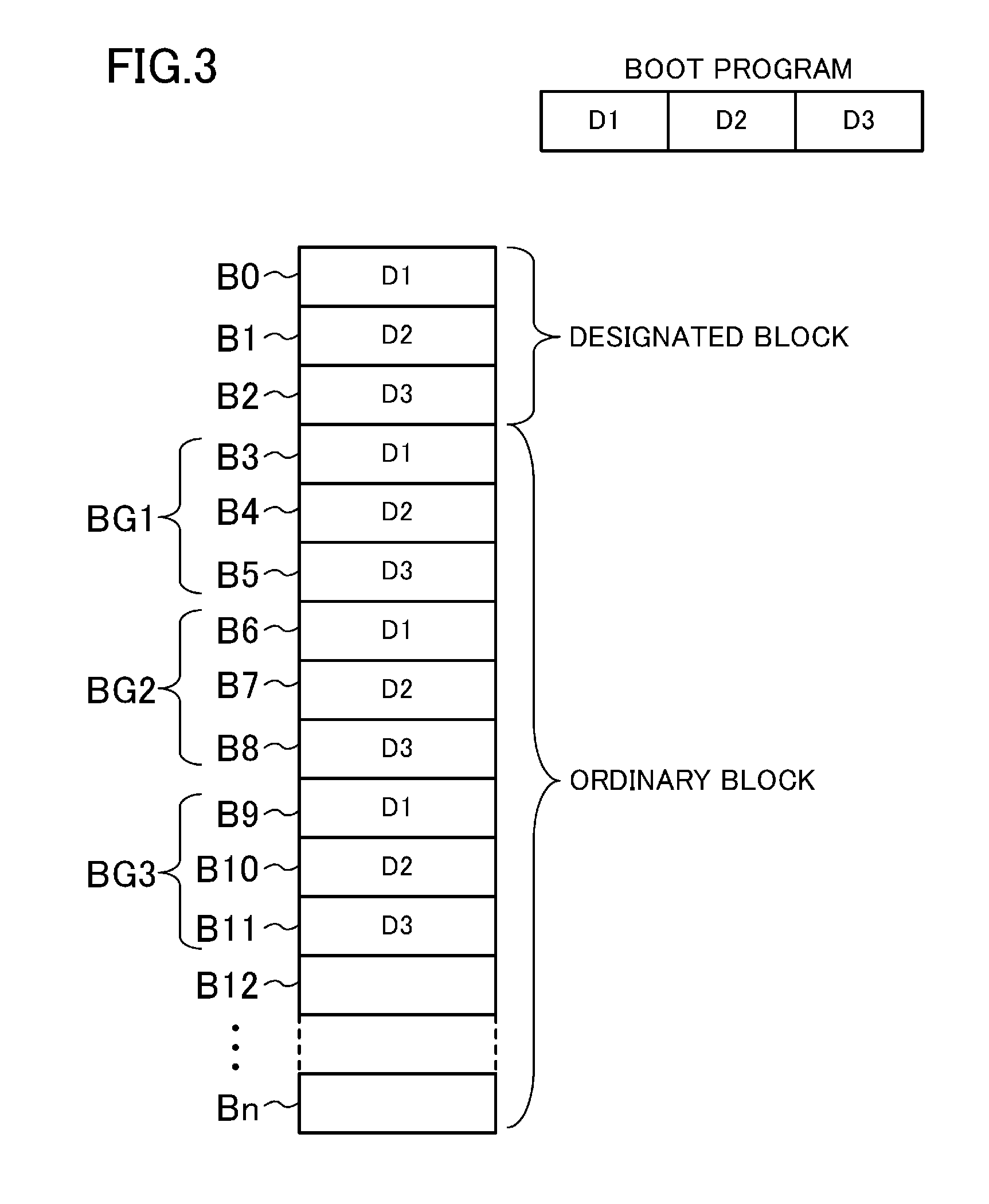Data processing method and semiconductor integrated circuit
a data processing and semiconductor technology, applied in the field of data processing methods and semiconductor integrated circuits, can solve the problems of difficult to increase data read reliability and another block with a lower degree of reliability, and achieve the effects of reducing the faulty operation of the semiconductor device, accurate reconstruction, and increasing data read reliability
- Summary
- Abstract
- Description
- Claims
- Application Information
AI Technical Summary
Benefits of technology
Problems solved by technology
Method used
Image
Examples
first embodiment
[0032]FIG. 1 illustrates an example configuration of a semiconductor device according to a first embodiment. The semiconductor device includes a NAND type flash memory 10, and a system LSI 11 (semiconductor integrated circuit). The NAND type flash memory 10 is provided outside the system LSI 11. The system LSI 11 includes a variety of circuits integrated on a single semiconductor chip.
[0033][NAND Type Flash Memory]
[0034]The NAND type flash memory 10 stores a variety of processing programs and data including a boot program to activate the semiconductor device.
[0035]As illustrated in FIG. 2, the NAND type flash memory 10 includes a plurality of blocks B0, B1, . . . , Bn (n≧2). Each of the blocks B0, B1, . . . , Bn includes a plurality of pages P0, P1, . . . , Pm (m≧2). Unique block numbers (0, 1, . . . , n) are assigned to the blocks B0, B1, . . . , Bn, respectively. Unique page numbers (0, 1, . . . , m) are assigned to the pages P0, P1, . . . , Pm, respectively. In accessing the NAND...
second embodiment
[0090]FIG. 6 illustrates an example configuration of a semiconductor device of a second embodiment. The semiconductor device has the configuration of the semiconductor device illustrated in FIG. 1, and in addition, a non-volatile memory 20. Note that the non-volatile memory 20 may be provided inside the system LSI 11 or may be provided outside the system LSI.
[0091]In the course of using the NAND type flash memory 10, the number of unreadable blocks in the NAND type flash memory 10 randomly increases. Thus, when access to the NAND type flash memory 10 is performed without the unreadable blocks being avoided, the start-up time of the semiconductor device may increase as the number of unreadable blocks increases. The semiconductor device illustrated in FIG. 6 performs the process of storing boot history information (information indicating from which blocks the divided programs D1, D2, D3 have been able to be normally read) in the non-volatile memory 20, and the process of sequentially ...
third embodiment
[0110]FIG. 11 illustrates an example configuration of a semiconductor device of a third embodiment. The semiconductor device includes a system LSI 31 instead of the system LSI 11 illustrated in FIG. 6. The system LSI 31 has the configuration of the system LSI 11 illustrated in FIG. 1, and in addition, a block copy determination circuit 301. For example, the block copy determination circuit 301 compares the number of unreadable blocks of each of the divided programs D1, D2, D3 with a preset threshold value, and outputs a copy request signal (signal to request that each of the divided programs D1, D2, D3 is copied to an unused block).
[0111]For example, in the NAND type flash memory 10, as illustrated in FIG. 7, when three of four blocks (the designated block B2 and the ordinary blocks B5, B8, B11) each storing the divided program D3 are unreadable blocks, the divided program D3 cannot be normally read if the ordinary block B11 becomes an unreadable block, so that the boot program cann...
PUM
 Login to View More
Login to View More Abstract
Description
Claims
Application Information
 Login to View More
Login to View More - R&D
- Intellectual Property
- Life Sciences
- Materials
- Tech Scout
- Unparalleled Data Quality
- Higher Quality Content
- 60% Fewer Hallucinations
Browse by: Latest US Patents, China's latest patents, Technical Efficacy Thesaurus, Application Domain, Technology Topic, Popular Technical Reports.
© 2025 PatSnap. All rights reserved.Legal|Privacy policy|Modern Slavery Act Transparency Statement|Sitemap|About US| Contact US: help@patsnap.com



